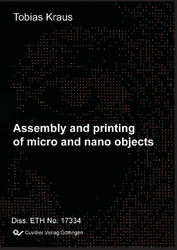| Fachbereiche | |
|---|---|
| Buchreihen (96) |
1378
|
| Nachhaltigkeit |
3
|
| Gesundheitswesen |
1
|
| Geisteswissenschaften |
2364
|
| Naturwissenschaften |
5406
|
| Ingenieurwissenschaften |
1793
|
| Allgemeine Ingenieurwissenschaften | 292 |
| Maschinenbau und Verfahrenstechnik | 862 |
| Elektrotechnik | 686 |
| Bergbau- und Hüttenwesen | 30 |
| Architektur und Bauwesen | 75 |
| Allgemein |
98
|
|
Leitlinien Unfallchirurgie
5. Auflage bestellen |
|
Erweiterte Suche
Assembly and Printing of Micro and Nano Objects
Tobias Kraus (Autor)Vorschau
Inhaltsverzeichnis, Datei (34 KB)
Leseprobe, Datei (56 KB)
Materials can be fabricated using particles as building blocks. Particles from various substances can thus be introduced into normally incompatible matrices, the unique properties of very small particles can be exploited, and different properties of different particles can be combined by mixing them in a material. Even very small particles are readily synthesized with high quality using modern chemical methods. Size ranges and material combinations that are usually difficult to attain can thus be achieved easily.
In contrast to other methods, particle-based approaches allow us to fabricate regular structures at very small scales. The arrangement of particles in such structures is possible via self-assembly, which often is the only economical approach for small particle sizes. This work shows that certain conditions have to be fulfilled for self-assembly to be useful in technological applications. A concept is suggested that meets these requirements by combining templated self-assembly with adhesion-based particle handling.
Using these methods, particles with diameters between 100 μm and 60 nm are assembled, transferred, and integrated on standard substrates without predefined surface structures. This produces materials with particles that retain their specific activities. Metal-coated microbeads provide electrical contact to semiconductors. Precisely arranged polymer beads protect sub-micrometer-scale parts of a surface in etch processes to yield metal nanodiscs or silicon nanorods. Gold nanocrystals remain catalytically active and nucleate the growth of silicon nanowires in a CVD process. Such nanocrystals are also optically active and sensitive to the refractive index of their immediate surroundings, which makes them useful in biological assays and similar analytical problems.
In this work, we use several methods for the self-assembly of particles, all of which are based on topographical templates. Large particles (100 μm in diameter) can be assembled in a dry state from a fluidized bed. Smaller particles are generally handled as suspensions and have to be brought from the liquid phase onto a surface. To this end, we exploit capillary forces, which are present in all drying processes, and direct them using specialized surface topographies. The transport of the colloidal particles has to adjusted such as to create an accumulation zone with high local concentrations. This is done by tuning the substrate temperature (and thus, the evaporation rate), but also by using surfactants, which bias contact angle and stability of the suspension. We show that a large increase in local concentration is required when using small particles, which behave in a strongly stochastic manner owing to Brownian Motion.
The passive handling of particles applied here is based on controlled particle adhesion in so-called adhesion cascades and reminds of the ink transfer in traditional printing. Different surfaces exert differently strong adhesion forces on the particles with which they come in contact. We modify and combine surfaces such that in every step the target substrate provides a stronger adhesion than the previous surface did. It becomes clear that the geometry of the particle-surface contact has a large influence on adhesion, so that mechanical properties of the surfaces influence particle adhesion, as their surface can conform to the particle’s surface more or less. This dependence of adhesion on the contact geometry is strong enough even in small particles to enable the transfer of nanocrystals solely through contact area differences.
The combination of self-assembly and transfer makes our method modular and compatible with existing techniques. We demonstrate this by its repeated application, which yields hierarchical structures containing different particle sizes. The method should also scale to very small particles, possibly using other self-assembly processes. We demonstrate one possible route for thiol molecules, which can be patterned in gradients by controlling their transport.
| ISBN-13 (Printausgabe) | 3867273774 |
| ISBN-13 (Printausgabe) | 9783867273770 |
| ISBN-13 (E-Book) | 9783736923775 |
| Buchendformat | A5 |
| Sprache | Englisch |
| Seitenanzahl | 342 |
| Auflage | 1 |
| Band | 0 |
| Erscheinungsort | Göttingen |
| Promotionsort | München |
| Erscheinungsdatum | 28.09.2007 |
| Allgemeine Einordnung | Dissertation |
| Fachbereiche |
Allgemeine Ingenieurwissenschaften
|








